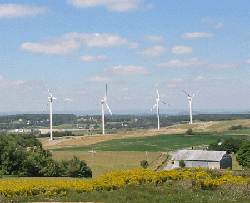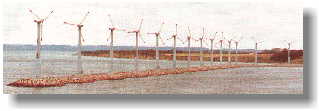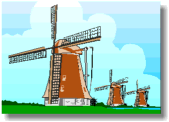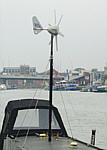![]()
![]()
![]()
![]()
![]()
![]()
![]()
![]()
![]()
![]()
![]()
This site is designed to be viewed on an
800 x 600 screen,
with level 4+ browsers.
Created by Andy Darvill,
Science teacher at
Broadoak Community School,
Weston-super-Mare, England
Web site www.darvill.clara.net
Introduction How it works More details Advantages Disadvantages Is it renewable?
![]()
![]()
How it works
|
The Sun heats our atmosphere unevenly, so some patches become warmer than others. These warm patches of air rise, other air blows in to replace them - and we feel a wind blowing. We can use the energy in the wind by building a tall tower, with a large propellor on the top. |
 |
 |
The wind blows the propellor round, which turns a generator to produce electricity. We tend to build many of these towers together, to make a "wind farm" and produce more electricity. The more towers, the more wind, and the larger the propellors, the more electricity we can make. It's only worth building wind farms in places that have strong, steady winds, although boats and caravans increasingly have small wind generators to help keep their batteries charged. |
![]()
More details
|
The best places for wind farms are in coastal areas, at the tops of rounded hills, open plains and gaps in mountains - places where the wind is strong and reliable. To be worthwhile, you need an average wind speed of around 25 km/h. Most wind farms in the UK are in Cornwall or Wales. |
 |
Isolated places such as farms may have their own wind generators. In California, several "wind farms" supply electricity to homes around Los Angeles.
The
propellors are large, to extract energy from the largest possible volume
of air. The blades can be angled to "fine" or "coarse"
pitch, to cope with varying wind speeds, and the generator and propellor
can turn to face the wind wherever it comes from.
Some designs use vertical turbines, which don't need to be turned to
face the wind.
The towers are tall, to get the propellors as high as possible, up to where the wind is stronger. This means that the land beneath can still be used for farming.
See Also:
 |
News, views and analyses from the world's leading independent wind energy magazine, Windpower Monthly, at www.windpower-monthly.com |
 |
The British Wind Energy Association at www.bwea.com |
| Wind generators for home use: www.windsave.com |
See also: www.fuelfromthewind.com
![]()
Advantages
- Wind is free,
wind farms need no fuel.
- Produces no
waste or greenhouse gases.
- The land beneath
can usually still be used for farming.
- Wind farms
can be tourist attractions.
- A good method of supplying energy to remote areas.
![]()
![]()
Is it renewable?
Wind power is renewable. Winds will keep on blowing, it makes sense to use them.
![]()
|
|
|
Find out more, including grants towards installation, at www.cus.net Want to discuss
alternative energy issues? |

